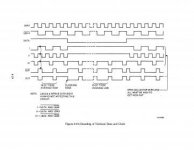legalize
Experienced Member
Has anyone hacked the VT100 keyboard to see what kind of sounds you can coax out of the speaker other than the key click (1 tick of the speaker circuit) vs the bell (200 ticks of the speaker circuit that averages out to a perceived tone)?
I'm wondering if any other pitches could be induced by changing the 200 ticks to something else.
For those that aren't intimately familiar with the VT100 keyboard connection, it's a 3-wire connection on a TRS jack with +12 V, ground and signal. The single signal line is used for bidirectional communication between the terminal and the keyboard. The keyboard is a slave device and the key click and bell noises from the keyboard's speaker are controlled by a bit in the command byte sent to the keyboard periodically.
I'm wondering if any other pitches could be induced by changing the 200 ticks to something else.
For those that aren't intimately familiar with the VT100 keyboard connection, it's a 3-wire connection on a TRS jack with +12 V, ground and signal. The single signal line is used for bidirectional communication between the terminal and the keyboard. The keyboard is a slave device and the key click and bell noises from the keyboard's speaker are controlled by a bit in the command byte sent to the keyboard periodically.

